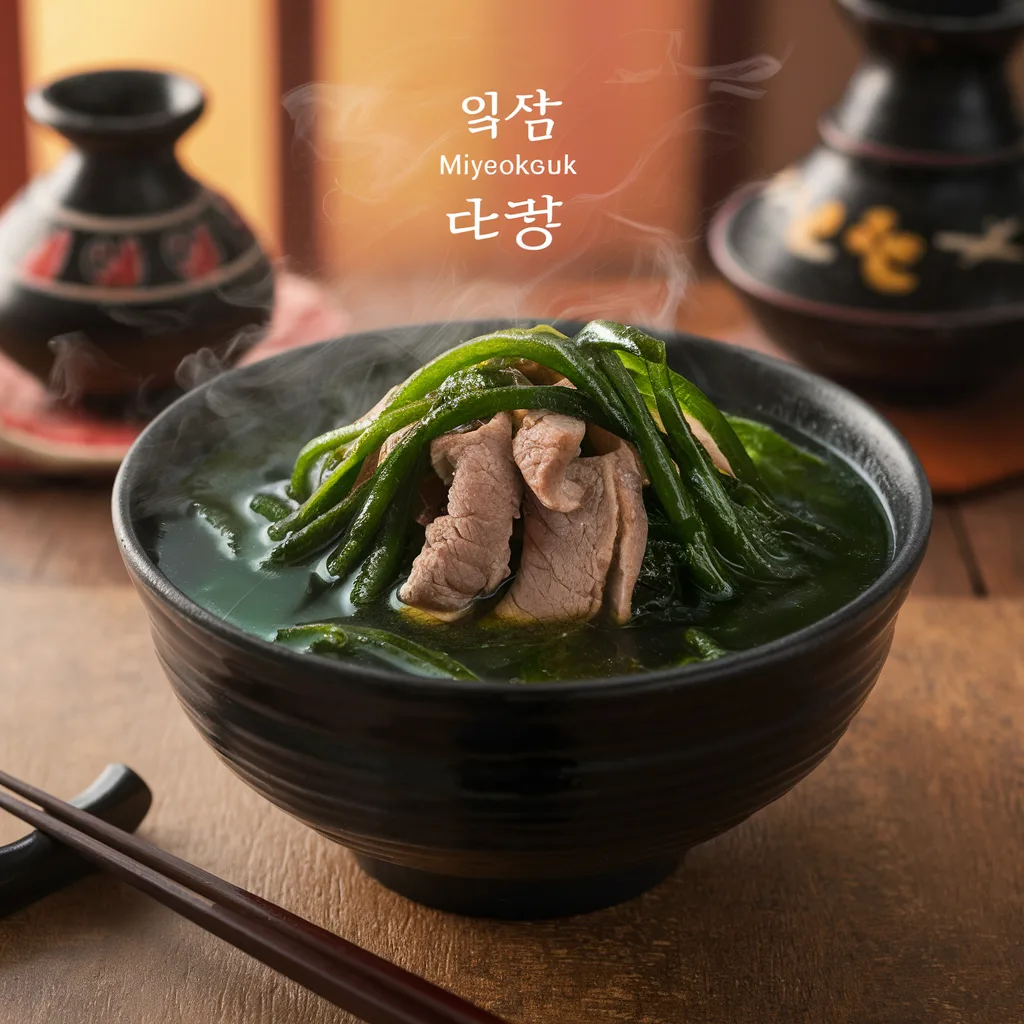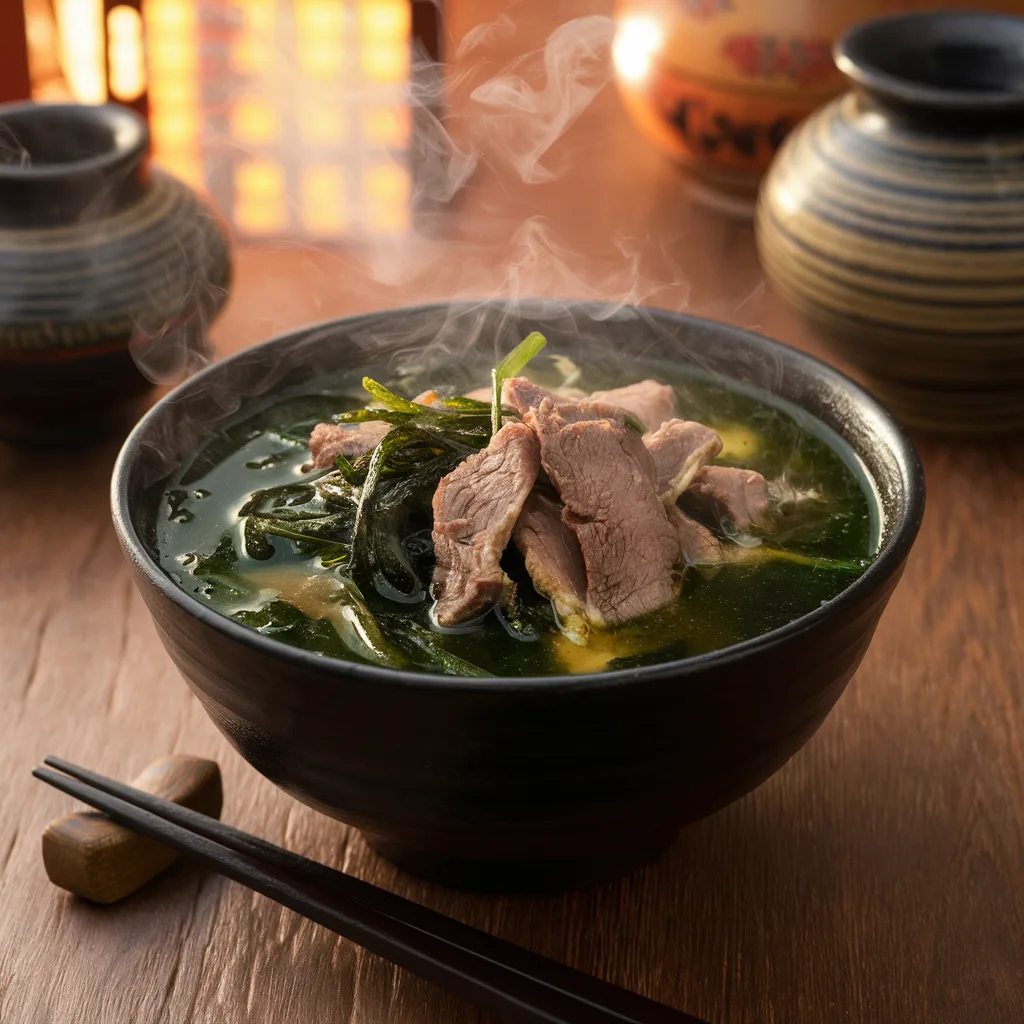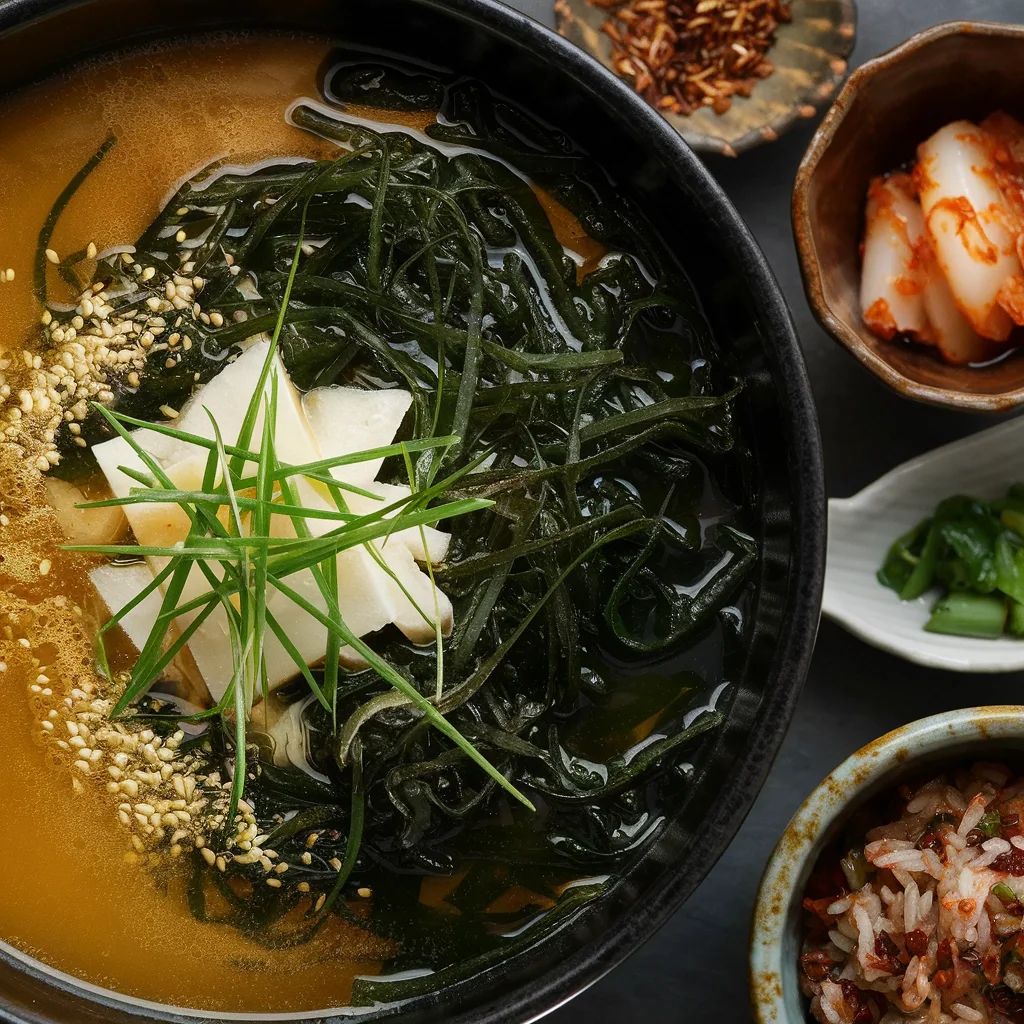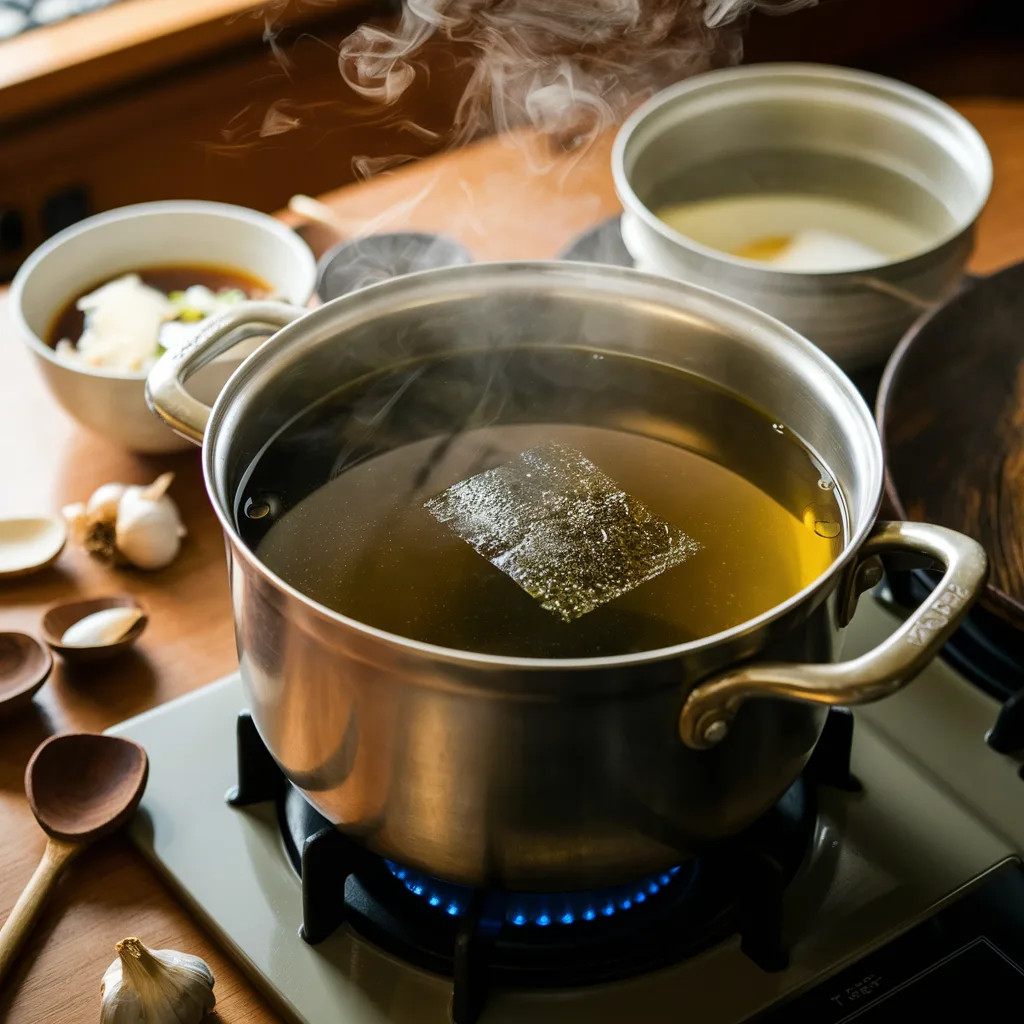I still remember the smell of seaweed soup in my grandmother’s kitchen. It was a comforting broth with a deep umami flavor from dried seaweed. This soup was a special tradition that brought our family together. Korean seaweed soup, or miyeokguk, holds a deep cultural value in many homes.
If you love cooking or are new to Korean seaweed soup, this guide has five key tips. You’ll learn how to make a delicious, light, and authentic miyeokguk. From picking the right ingredients to mastering the cooking techniques, you’ll soon be making a bowl of comfort and nutrition.
Key Takeaways
- Discover the cultural significance of miyeokguk in Korean cuisine
- Learn about the different types of edible seaweed used in the soup
- Understand the importance of properly rehydrating and preparing the seaweed
- Explore tips for crafting a flavorful broth base for your seaweed soup
- Uncover the nutritional benefits and health properties of this umami-rich dish
Understanding Traditional Seaweed Soup
Seaweed soup is very important in Asian food, especially in Korea. It’s given to new moms to help them recover and to kids on their birthdays. The main seaweed is miyeok, which looks a lot like Japanese wakame.
Cultural Significance in Asian Cuisine
In Korea, miyeok-guk, or seaweed soup, is a big deal on special days. It’s thought to fill up nutrients and vitamins lost during childbirth. So, it’s a big part of new moms’ recovery. Also, kids get it on their birthdays for a healthy start.
Types of Edible Seaweed Used
- Miyeok (Korean seaweed), similar to wakame used in Japanese miso soup
- Kombu, a type of kelp, commonly used to make the dashi broth in Japanese cuisine
- Limu, a variety of seaweed found in Chinese kelp soup
Historical Background
Seaweed soup has been around for centuries in Asia. It’s known for its health benefits across cultures. In Korea, miyeok has been used since the Joseon dynasty. Japan uses wakame in their miso soup. These soups are key to their food traditions.
“I ate the same seaweed soup for 450 consecutive days after giving birth. It’s a tradition that’s deeply rooted in Korean culture.”
Essential Ingredients for Perfect Seaweed Soup
Making a great seaweed soup starts with choosing the right ingredients. The base is miyeok, a type of dried seaweed. It gives a light, salty taste and a soft texture. Beef or pork adds a meaty flavor to the broth.
Rice water is added to deepen the soup’s taste. It adds a subtle flavor that goes well with the other ingredients. Korean soup soy sauce, or guk-ganging, is key for the soup’s unique taste.
Korean tuna sauce is optional but can make the broth even better. It adds a hint of umami that balances the flavors. With these ingredients, you can make a seaweed soup that’s both cozy and true to its roots.
- Dried miyeok (edible seaweed): The main flavor and texture source.
- Beef or pork: Makes the broth hearty and rich.
- Rice water: Adds a subtle flavor to the soup.
- Guk-ganging (Korean soup soy sauce): Brings out the savory, umami taste.
- Optional: Korean tuna sauce – Adds a touch of umami to the broth.
Mastering these ingredients lets you make a seaweed soup that’s both healthy and tasty. It truly captures the spirit of Korean cooking.
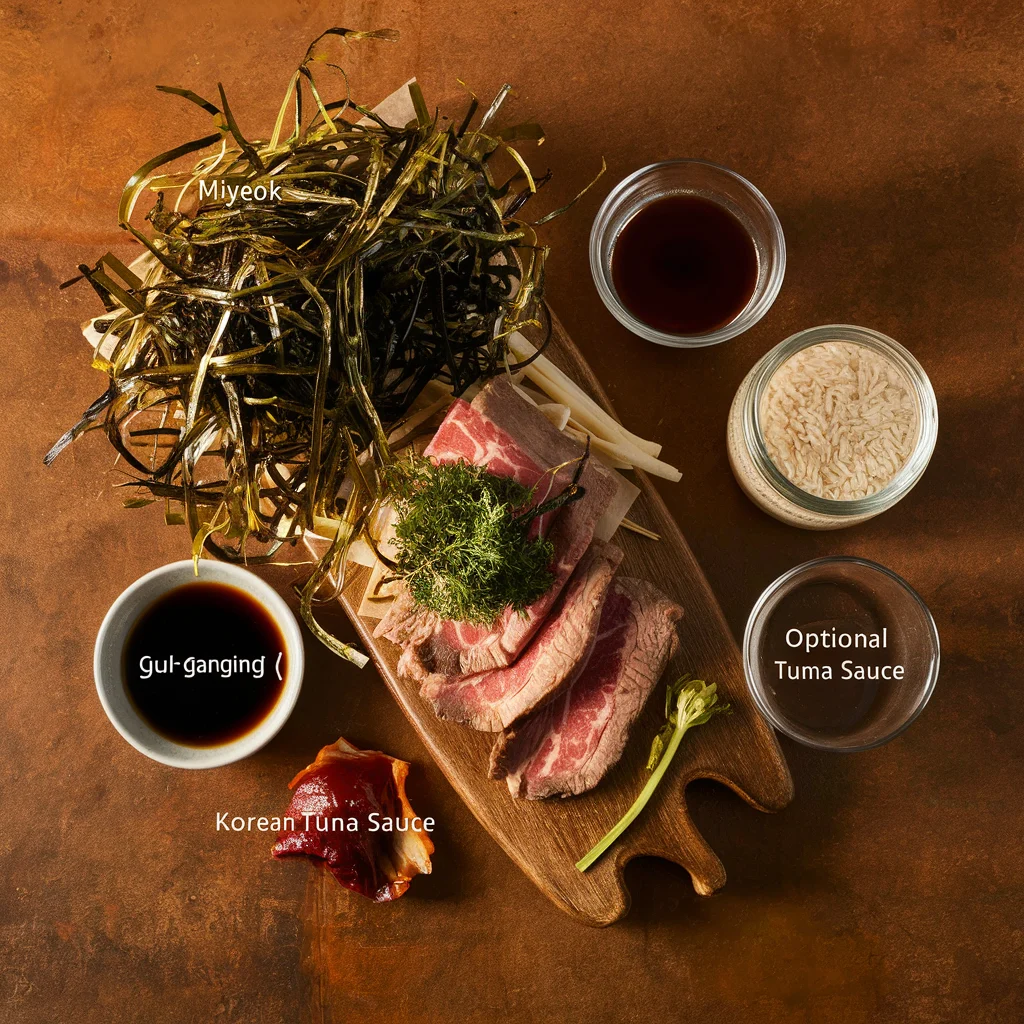
The Art of Selecting and Preparing Seaweed
Choosing the right dried seaweed is key to making a tasty seaweed soup. Look for dried miyeok (sea laver) that’s dark green and thin. This means it’s of high quality and will taste better.
When soaking the seaweed, aim for 10-15 minutes. Don’t soak it too long, as this can ruin the taste and texture.
Quality Indicators for Dried Seaweed
The quality of dried seaweed shows in its color and texture. Choose sea laver that’s vibrant and firm. Wakame should be soft and grow a lot when soaked.
Storage and Preservation Tips
Keep your dried seaweed fresh by storing it in an airtight container. Place it in a cool, dry spot away from sunlight and moisture. When you’re ready to use it, soak it in water for the right amount of time before adding it to your soup.
Proper Rehydration Techniques
Rehydrating dried seaweed is crucial for a tasty soup. Soak sea laver or wakame in cold water for 10-15 minutes, stirring gently. This keeps the seaweed’s texture and flavor. Don’t soak it too long, or it will lose taste and become mushy.
| Seaweed Type | Rehydration Time | Expansion Rate |
|---|---|---|
| Dried Miyeok (Sea Laver) | 10-15 minutes | 2-3 times original size |
| Wakame | 30 minutes | 4-5 times original size |
Building the Perfect Broth Base
The heart of a tasty seaweed soup is its broth. Traditional Japanese dashi broth mixes kombu (dried kelp) with bonito flakes for a rich umami taste. But, for a vegetarian option, just kombu can make a flavorful base.
To make a smooth broth, simmer the kombu carefully. This prevents it from becoming too bitter. Adding rice water can also enrich the soup’s flavor. For miso-based soups, mix miso paste with hot broth first. This makes sure it blends well without any lumps.
| Ingredient | Quantity |
|---|---|
| Dried organic kombu flakes | 1 1/2 cups |
| Dried organic wakame flakes | 1 1/2 cups |
| Dried shiitake mushrooms | 1 tablespoon |
| Nutritional yeast | 2 tablespoons |
| Sea salt | 1 teaspoon |
Learning to make the perfect broth base is key. It brings out the full flavor and aroma of a great seaweed soup.
“The secret to a captivating seaweed soup lies in the careful preparation of its foundation – the broth.”
Mastering Seaweed Soup Preparation
Making a tasty seaweed soup is more than just throwing ingredients together. You need to control the temperature, timing, and use special techniques. Let’s dive into the details of making this favorite dish.
Temperature Control Guidelines
Keeping the right temperature is key when making seaweed soup. Don’t let the miso boil, as it can lose its health benefits. Instead, simmer it gently to keep the flavors intact.
To get the perfect oil mix, blend sesame oil with oils like avocado or grapeseed. This mix ensures the soup simmers evenly without burning.
Timing and Cooking Stages
Timing is everything in seaweed soup. Start by soaking the seaweed for 10-15 minutes. This makes it rehydrate properly.
Then, simmer the kombu (kelp) for about 10 minutes. This step extracts its rich umami flavors. After that, add the seaweed and tofu, and simmer for 1-2 minutes. This lets the flavors mix well.
Professional Kitchen Techniques
Experienced chefs use special tricks to make their seaweed soup stand out. One technique is adding rice water to deepen the broth’s flavor. They also balance the seasoning with Korean soup soy sauce and tuna sauce. This creates a perfect seasoning balance.
By mastering temperature control, timing, and professional techniques, you can make a truly amazing seaweed soup. It will delight your taste buds with every spoonful.
“The secret to a truly exceptional seaweed soup lies in the nuanced interplay of temperature, timing, and seasoning. With a little practice, you’ll be simmering, blending, and balancing your way to soup perfection.”
Nutritional Benefits and Health Properties
Seaweed soup is a nutritional powerhouse, packed with essential vitamins, minerals, and fiber. It’s an iodine-rich fare, a true marine superfood. It offers many health benefits for those looking for a low-calorie, nutrient-dense potage.
Seaweed, the key ingredient, is renowned for its high iodine content. Just a few grams of certain seaweed varieties can provide over 100% of the recommended daily intake of iodine. Iodine is vital for thyroid health and regulating metabolism. This makes seaweed soup great for postpartum recovery and breastfeeding mothers.
But seaweed’s nutritional value goes beyond iodine. It’s also rich in vitamins A, B, C, and K, and essential minerals like calcium, iron, magnesium, and zinc. The fiber in seaweed, which can be 35-60% of its dry weight, is higher than most fruits and vegetables. This makes it a low-calorie dish that’s good for your gut.
Studies show that eating seaweed can improve thyroid function and gut health. It can also lower cholesterol and blood sugar levels. The antioxidants in seaweed, like fucoxanthin, may help fight cancer and support weight management.
Looking to boost your nutrient intake or support your overall well-being? Seaweed soup is a remarkable choice. It’s a delicious, low-calorie meal that can enhance your health and wellness.
“Seaweed is a true treasure trove of essential nutrients, making it a must-have ingredient for anyone seeking a nutrient-dense, low-calorie meal option.”
Complementary Ingredients and Garnishes
Make your seaweed soup better with the right ingredients and garnishes. You can keep it traditional with silken tofu and green onions. Or, try new fusion ingredients for exciting tastes.
Traditional Accompaniments
In Asian cooking, seaweed soup goes well with kkakdugi (radish kimchi) and japgokbap (multigrain rice). The soup’s umami matches the kimchi’s tang and the rice’s nuttiness.
Modern Fusion Additions
For a fresh take, add shiitake mushrooms, daikon radish, or fresh veggies like spinach and carrots. These ingredients boost the soup’s health benefits and add new flavors.
| Ingredient | Contribution |
|---|---|
| Silken tofu | Provides a creamy, soft texture and a subtle flavor that complements the seaweed |
| Green onions | Adds a fresh, aromatic element and a touch of crunch to the soup |
| Kkakdugi (radish kimchi) | Offers a tangy, crunchy contrast to the soothing, savory soup |
| Japgokbap (multigrain rice) | Serves as a hearty, nutty accompaniment that balances the lightness of the soup |
| Shiitake mushrooms | Lend an earthy, umami-rich flavor and a meaty texture to the dish |
| Daikon radish | Provides a refreshing crunch and a slightly peppery note to complement the seaweed |
Using both traditional and modern fusion ingredients, you can make a seaweed soup that’s healthy and full of flavor.
Serving Suggestions and Presentation
Serve your seaweed soup hot right after you make it. It’s great as a starter, side dish, or even a main meal. For more flavor, offer tamari on the side. This lets your guests add their own taste.
Pair the soup with cooked rice or soba noodles for a bigger meal. Or, add it to a Japanese or Korean feast. It goes well with tamago kake gohan or okonomiyaki. This soup is perfect for a wide range of dishes.
To enjoy seaweed soup at its best, eat it fresh and hot. Its flavors and textures are best when it’s straight from the pot. This way, you and your guests can fully enjoy this traditional Asian dish.


